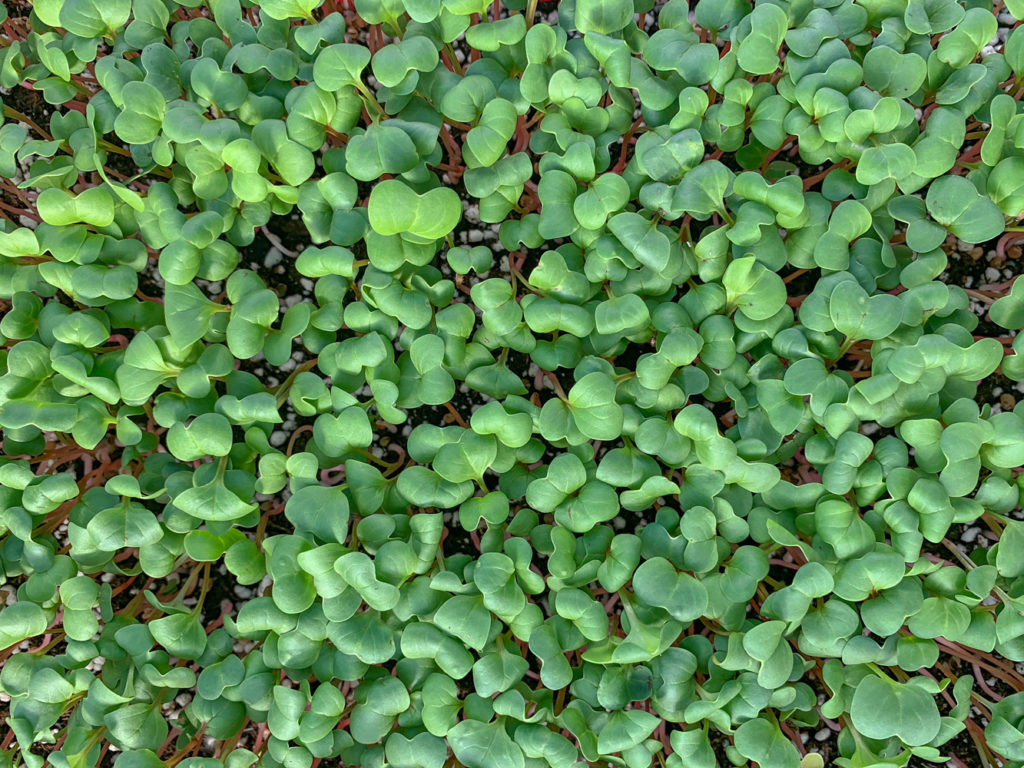Have you heard about microgreens lately? If you have, you’re not alone; they are very trendy right now and are taking the horticulture and culinary scenes by storm! At the Big Tex Urban Farms we’ve started harnessing the power of microgreens in our greenhouse and during the Fair this year we had the humble opportunity to educate curious people about them. So what’s the deal with microgreens and why are they all the rage?
What is a Microgreen?
In a nut shell, microgreens – sometimes just called “micros” – are plants that sprouted from seeds that are placed very close together, thus causing a super dense area of growth. Once sprouted, these plants are then only allowed to grow to a very small size and are harvested “young” compared to other plants. With many varieties to choose from, microgreens come in many shapes, sizes, colors, and flavors. This broad palette of shapes and colors make them very popular garnishes for chefs to use. They are also a very healthy addition to any diet.
What plants make good microgreens?
Almost any edible plant can be grown as a microgreen but some plants allow for better growth than others. Most farmers and home gardeners prefer to use leafy greens and herbs for microgreens; like lettuce. Peas and certain varieties of beans are also popular. Some of the most standard garden plants make great microgreens, including broccoli, collards, mustard, and basil. The Big Tex Urban Farms soon plans to add pea shoots and fava beans to our microgreens but we’re already quickly growing collards, mustard, arugula, basil, and radish. I love the spicy flavor of all of these varieties!

How we grow Microgreens: The Hydroponic Method
In the Greenhouse on the Midway, the Big Tex Urban Farms grows micros on long, rectangular 10-inch by 20-inch trays using hydroponics and potting soil. In the hydroponic method we use a product called a cress plate to start our seeds on. Cress plates are thin sheets of rockwool (the sheets we use to start our hydroponic transplants with are made of this also!) that fit inside of our trays. Before placing anything on it, we first wet the cress plate then cover it with a thin even layer of seeds. Seeds are then watered lightly. If we’re planting several trays of micros, we stack the seeded and watered trays on top of each other, completing the stack with an empty tray on top. Lastly, we place a small concrete block on top of the empty tray at the top of the stack! This may sound crazy but it works and here’s why: the weight from the concrete block creates compression and causes the seeds to germinate faster.
After about three days the seeds will be germinated and will literally press upward and lift the top tray up – rock and all. At this point the trays are spaced out on one of our grow racks and continue growing under LED grow lights until they’re ready to be harvested; usually seven to 10 days.

How we grow Microgreens: The Potting Soil Method
Growing microgreens using the potting soil method is very similar to the hydroponic method. We simply fill the 10-inch by 20-inch trays with potting soil instead of using a cress plate and then repeat the process above. When all the trays have sprouted we uncover them and put them on a table rather than a grow rack like the cress plate sprouts. These soil based trays are not given artificial light and rely solely on the natural sunlight in our greenhouse to finish growing. That being said, we do sometimes add supplemental lighting to our microgreens when the short days of winter approach. Potted soil microgreens are usually ready in harvest in about 14 days.
In my opinion, the potting soil method for growing micros is easy enough for anybody to use at home. A bright sunny windowsill or a shady patio would be an ideal spot to grow micros. The use of an LED grow light can also allow you to do this anywhere in the home and allow microgreen farming year round. I particularly like the fact that the potting soil used in this method is compostable and reusable in time.

Small but Powerful
In addition to their flavor and cosmetic appeal micros pack a ton of nutritional value too! They might be small when harvested but they are filled with vitamins and antioxidants. In fact, it’s said that you can get the same amount of nutritional content from a hand full of microgreens as you can get from a whole head of lettuce. The Brassica family of plants, in particular, are thought to have strong regenerative and anti-carcinogenic properties so varieties like broccoli, cabbage, collards, and mustard make for super healthy micros.
Eating microgreens can be a quick and easy way to add necessary nutrients to your diet. Think of micros as living multivitamins. Consider adding them to your favorite sandwich, wrap, smoothie or juice to get your day started off right. This time of year you can even use them to accent your favorite Thanksgiving dish!

In Other Parts of the Garden
Around the home garden don’t forget that fall is the best time to plant trees and hardy shrubs. Even things like roses, irises, and berries can be planted now. To add some color to your landscape, it’s time to start planting my favorite winter flower, pansies, (totally edible flowers by the way) as well as ornamental kale, cabbage, and violas. Also, be sure to mulch your beds and get ready to winterize those sensitive plants you may be growing as cold weather will soon be here.
–
That is all I have for now. Hope you enjoyed the lil’ lesson on microgreens. Happy Thanksgiving! I’ll be back soon and until then happy gardening.
